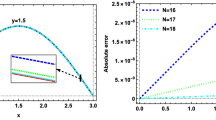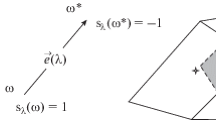The implicit finite difference method for solving deformation problems of mechanics of piecewise-homogeneous bodies is presented. The method is based on approximating the sought-for quantities by polynomials with indeterminate coefficients. It allows one to approximate the derivatives in resolving equations based on a grid with an irregular, in general, arrangement of nodal points. Relations were given for one-, two-, and three-dimensional approximations of the second-order of accuracy. This method was applied to studying the deformation of an elastic rotating cylinder whose matrix is reinforced in the circumferential directions with one layer of round fibers. The material configuration of the cylinder at large displacements and deformations are presented together with the stresses of contact interaction between the matrix and fibers. Its deformation characteristic, which reflects the continuation of the solution of the problem in terms of rotation speed, is determined. The results obtained are compared with the solution of the problem for a cylinder with square fibers at the same filling found by the methods of implicit finite differences and the traditional method of finite differences. Boundary-value problems for a thick-walled cylinder made of an isotropic material are also solved in nonlinear and linear formulations with uniform and nonuniform distributions of nodal points across the cylinder thickness, and the results obtained are compared with the exact solution of the corresponding linear problem.









Similar content being viewed by others
References
A. K. Malmeister, V. P. Tamuzh, and G. A. Teters, Resistance of Polymer and Composite Materials [in Russian], Riga: Zinatne (1980).
E. I. Grigolyuk and G. M. Kulikov, Multilayer Reinforced Shells. Calculation of Pneumatic Tires [in Russian], M.: Mashinostroenie (1988).
V. V. Kirichevsky, Method of Finite Elements in Mechanics of Elastomers [in Russian], K.: Nauk. Dumka (2002).
K. F. Chernykh, Nonlinear Elasticity Theory in Machine-Building Calculations [in Russian], L.: Mashinostroenie, (1986).
G. A. Holzapfel, T. C. Gasser, and R. W. Ogden, “A new constitutive framework for arterial wall mechanics and a comparative study of material models,” J. Elasticity, 61, 1-48 (2000).
G. A. Holzapfel, T. C. Gasser, and M. Stadler, “A structural model for the viscoelastic behavior of arterial walls: Continuum formulation and finite element analysis,” Eur. J. Mech. A / Solids, 21, 441-463 (2002).
W. J. Poole, J. D. Embury, S. MacEwen, and U. Kocks, “Large strain deformation of a copper-tungsten composite system. 1. Strain distribution,” Philosoph. Mag. A, 69, No. 4, 645-665 (1994).
P. D. Nicolaou, H. R. Piehler, and S. Saigal, “Process parameter selection for the consolidation of continuous fiber reinforced composites using finite element simulations,” Int. J. Mech. Sci., 37, No. 7, 669-690 (1995).
M. Gotoh and A. B. M. Idris, “Finite-element simulation of deformation of fiber-reinforced materials in the plastic range. Model proposition and tensile behaviors,” JSME Int. J. Ser. A. Mech. Mater. Eng., 40, No. 2, 149-157 (1997).
L. Banks-Sills and V. Leiderman, “Macro-mechanical material model for fiber reinforced metal matrix composites,” Composites: Part B., 30, Jan., 443-452 (1999).
Yu. V. Kokhanenko, “Numerical study of edge effects in layered composites under uniaxial loading,” Prikl. Mekh., 46, No. 5, 29-45 (2010).
S. Sockalingam, J. W. Gillespie, and M. Keefe, “On the transverse compression response of Kevlar KM2 using fiberlevel finite element model,” Int. J. Solids Struct., 51, Jun., 2504-2517 (2014).
V. M. Akhundov, “Forming of a toroidal body with a cross-ply arrangement of fibers on the basis of a two-level carcas theory,” Mech. Compos. Mater., 53, No. 2, 253-266 (2017).
V. M. Akhundov, “A method for calculating the near-surface effect in piecewise-homogeneous bodies at large deformations on the basis of a two-level approach. materials,” Mech. Compos. Mater., 56, No. 2, 169-184 (2020).
F. L. Chernousko and V. P. Banichuk, Variational Problems of Mechanics and Control [in Russian], M.: Nauka (1973).
O. K. Zenkevich and K. Morgan, Finite Elements and Approximation [Russian translation], M.: Mir (1986).
V. M. Akhundov and M. M. Kostrova, “Nonlinear deformation of a piecewise-homogeneous cylinder under the influence of rotation,” Mech. Compos. Mater., 54, No. 2, 231-242 (2018).
V. M. Akhundov, I. Yu. Naumova, and A. A. Zabrodskaya, “Elastoreinforced pipe from three layers with ring fibers under the influence of internal pressure,” Visnik Zaporiz. Nats. Univ., No. 1, 4-13 (2019).
T. Shup, Solving Engineering Problems on a Computer [Russian translation], M.: Mir, (1982).
N. S. Bakhvalov, N. P. Zhidkov, and G. M. Kobelkov, Numerical Methods [in Russian], M.: Nauka (1987).
J. Ortega and V. Reinboldt, Iterative Methods for Solving Nonlinear Systems of Equations with Many Unknowns [Russian translation], M.: Mir (1975).
F. P. Vasiliev, Optimization Methods [in Russian], M.: Izd “Faktorial Press,” (2002).
A. I. Lurie, Nonlinear Elasticity Theory [in Russian], M.: Nauka (1980).
V. M. Akhundov, “Analysis of elastomeric composites based on fiber systems. 1. Development of a method for calculating composite materials,” Mech. Compos. Mater., 34, No. 6, 515-524 (1998).
V. Z. Parton and P. I. Perlin, Methods of mathematical elasticity theory [in Russian], M.: Nauka (1981).
S. D. Ponomarev, Strength Calculations in Mechanical Engineering,” S. D. Ponomarev et al., 3, 32-41, Mashgiz, Moscow (1959).
Author information
Authors and Affiliations
Corresponding author
Additional information
Translated from Mekhanika Kompozitnykh Materialov, Vol. 57, No. 6, pp. 1129-1154, November-December, 2021. Russian DOI: 10.22364/mkm.57.6.07.
Rights and permissions
About this article
Cite this article
Akhundov, V.M. The Impliсit Finite Difference Method in the Deformation Mechanics of Homogeneous and Piecewise Homogeneous Bodies. Mech Compos Mater 57, 795–812 (2022). https://doi.org/10.1007/s11029-022-10000-x
Received:
Revised:
Published:
Issue Date:
DOI: https://doi.org/10.1007/s11029-022-10000-x




